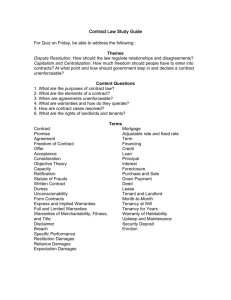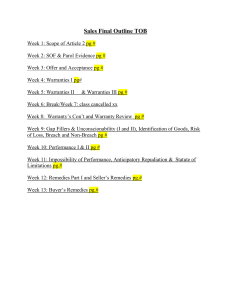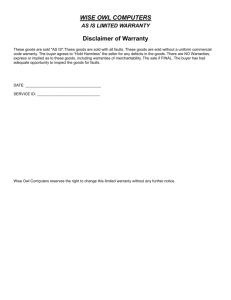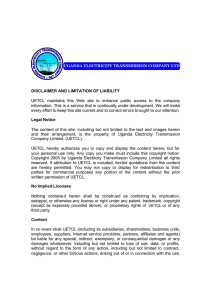Contract of Sale Terms: Conditions, Warranties, Representations
advertisement
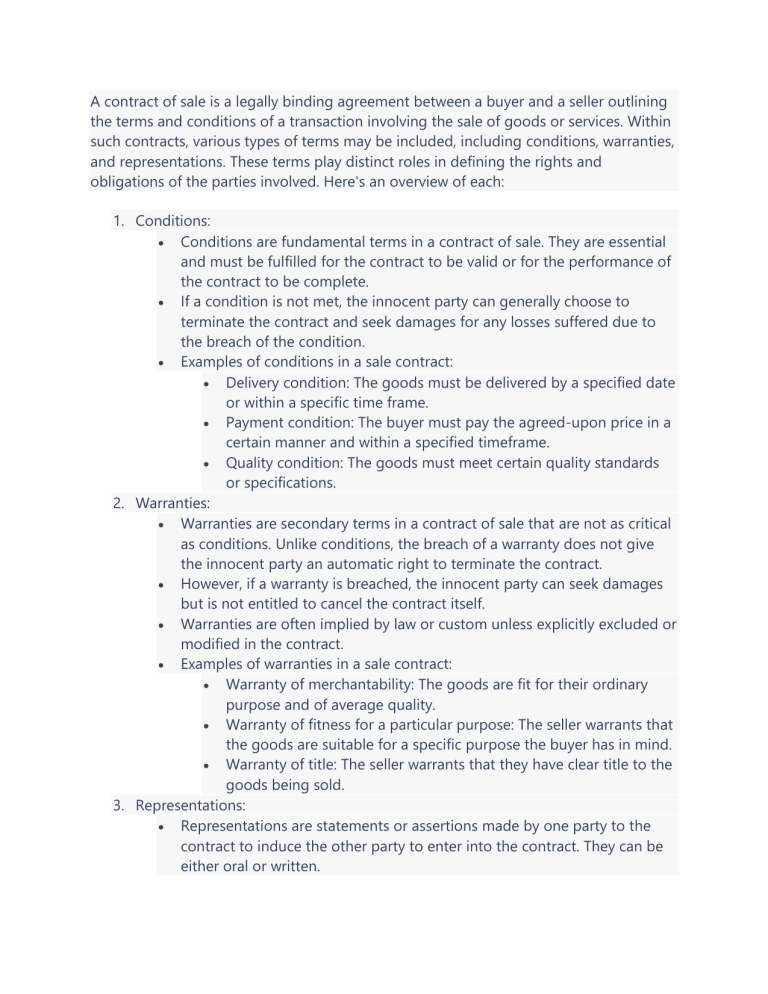
A contract of sale is a legally binding agreement between a buyer and a seller outlining the terms and conditions of a transaction involving the sale of goods or services. Within such contracts, various types of terms may be included, including conditions, warranties, and representations. These terms play distinct roles in defining the rights and obligations of the parties involved. Here's an overview of each: 1. Conditions: Conditions are fundamental terms in a contract of sale. They are essential and must be fulfilled for the contract to be valid or for the performance of the contract to be complete. If a condition is not met, the innocent party can generally choose to terminate the contract and seek damages for any losses suffered due to the breach of the condition. Examples of conditions in a sale contract: Delivery condition: The goods must be delivered by a specified date or within a specific time frame. Payment condition: The buyer must pay the agreed-upon price in a certain manner and within a specified timeframe. Quality condition: The goods must meet certain quality standards or specifications. 2. Warranties: Warranties are secondary terms in a contract of sale that are not as critical as conditions. Unlike conditions, the breach of a warranty does not give the innocent party an automatic right to terminate the contract. However, if a warranty is breached, the innocent party can seek damages but is not entitled to cancel the contract itself. Warranties are often implied by law or custom unless explicitly excluded or modified in the contract. Examples of warranties in a sale contract: Warranty of merchantability: The goods are fit for their ordinary purpose and of average quality. Warranty of fitness for a particular purpose: The seller warrants that the goods are suitable for a specific purpose the buyer has in mind. Warranty of title: The seller warrants that they have clear title to the goods being sold. 3. Representations: Representations are statements or assertions made by one party to the contract to induce the other party to enter into the contract. They can be either oral or written. Representations can be seen as statements of fact or opinion, and they are relied upon by the other party in deciding to enter the contract. If a representation is false, and the innocent party relied on it to their detriment, they may have a right to rescind the contract and seek damages. In some cases, a representation can become a term of the contract if it is included in the written agreement. It's important to distinguish between mere puffery (exaggerated marketing claims) and actionable representations. It's worth noting that the distinction between these terms can be complex, and legal systems may vary. In practice, the terms "condition," "warranty," and "representation" can sometimes overlap or be blurred depending on the specific wording of the contract and applicable laws. Parties to a contract should be clear in their intentions and seek legal advice if necessary to ensure that the contract terms accurately reflect their expectations and obligations. In India, like many other jurisdictions, a contract of sale typically involves various types of terms and clauses, including conditions, warranties, and representations. These terms play a crucial role in defining the rights and obligations of the parties involved in the sale of goods. Let's discuss these different types of terms in more detail: 1. Conditions: Essential Terms: Conditions are fundamental terms that go to the heart of the contract. They are vital to the performance of the contract, and if breached, the innocent party may have the right to terminate the contract and seek damages. Examples: In a contract of sale, conditions may include terms related to the price, quantity, quality, and description of the goods, as well as the delivery date and payment terms. Effects of Breach: If a condition is breached, the innocent party can treat the contract as void and seek remedies such as damages or specific performance. 2. Warranties: Secondary Terms: Warranties are subsidiary terms that are not as vital as conditions. They are not central to the contract's performance, and a breach of warranty does not entitle the innocent party to terminate the contract. Examples: Warranties in a sale contract might involve promises about the fitness for a particular purpose, the seller's title to the goods, or the absence of any encumbrances on the goods. Effects of Breach: If a warranty is breached, the innocent party can seek damages but cannot terminate the contract. 3. Representations: Statements of Fact: Representations are statements of fact made by one party to the other during the negotiation or formation of the contract. They are not terms of the contract itself but can influence the decision to enter into the contract. Examples: In a sale contract, representations could include statements about the condition of the goods, their origin, or their market value. Effects of Misrepresentation: If a representation is false and induces the other party to enter into the contract, the innocent party may have the right to rescind the contract (i.e., treat it as void) and claim damages. It's important to note that in Indian contract law, the Sale of Goods Act, 1930, governs the contracts of sale involving movable goods. This Act provides specific rules regarding conditions and warranties in sale contracts. Additionally, contracts of sale in India may also include other terms related to delivery, risk, payment methods, and dispute resolution mechanisms. Parties are encouraged to clearly specify these terms to avoid disputes and ensure the contract's enforceability. In summary, a contract of sale in India can include conditions, warranties, and representations, each serving a distinct role in defining the rights and responsibilities of the parties involved in the sale of goods. Understanding the differences between these terms is crucial for both buyers and sellers to protect their interests and comply with the applicable legal framework. Infringement of Copyright in the Indian Copyright Act, 1957 The Indian Copyright Act of 1957 is the legal framework that governs copyright protection in India, with several amendments made over the years to adapt to changing technological and creative landscapes. Copyright, under this Act, is a form of intellectual property protection granted to authors and creators of original works. It safeguards their unique expressions of ideas and allows for the commercial exploitation of these creations. Infringement of Copyright: Copyright infringement occurs when someone, without the proper license or in violation of the conditions set by a license, performs actions exclusive to the copyright holder, such as reproducing, distributing, or importing copies of the work for profit. Infringement also includes public performances without permission. Exceptions to Infringement: Certain acts are not considered infringement of copyright, such as fair dealing for research, private study, criticism, review, reporting current events, judicial proceedings, educational use, and more. These exceptions aim to balance the protection of intellectual property with the promotion of creativity, research, and education. Civil Remedies for Infringement: When copyright infringement occurs, copyright owners are entitled to remedies such as injunctions, damages, accounts, and other legal actions to protect their rights. Additionally, if an author's or publisher's name is associated with a work, they are presumed to be the actual author or publisher in copyright infringement proceedings unless proven otherwise. The Indian Copyright Act, 1957, provides a robust framework for protecting the rights of creators and fostering creativity while balancing the interests of society at large. It plays a vital role in nurturing India's vibrant and diverse creative landscape. n India, cybercrimes are addressed primarily under the Information Technology Act, 2000 (IT Act), which has been amended in subsequent years to address evolving cyber threats. Here are some common cybercrimes and their corresponding sections in the Indian legal framework: 1. Unauthorized Access and Hacking (Section 43, IT Act): Unauthorized access to computer systems or data is prohibited under this section. Hacking, which involves unauthorized entry into computer systems, is covered under Section 66 of the IT Act. 2. Data Theft (Section 66B, IT Act): This section deals with the punishment for dishonestly receiving stolen computer resources or communication devices. 3. Identity Theft (Section 66C, IT Act): Section 66C specifically addresses identity theft and the punishment for using someone else's identity for fraudulent purposes. 4. Online Fraud (Section 66D, IT Act): Online cheating and fraud are covered under this section, which deals with cheating by impersonation using a computer resource. 5. Phishing (Section 66E, IT Act): Phishing, where deceptive emails are used to steal sensitive information, falls under this section of the IT Act. 6. Data Breaches (Section 43A, IT Act): The IT Act requires organizations to implement reasonable security practices and procedures to protect sensitive personal data. Failure to do so can result in penalties under this section. 7. Child Pornography (Section 67B, IT Act): This section specifically addresses the publishing or transmitting of material depicting children in sexually explicit acts, which is a serious offense. 8. Cyberbullying and Online Harassment (Section 66A, IT Act): While Section 66A was struck down by the Supreme Court of India in 2015 for being vague and overbroad, harassment and cyberbullying cases can still be prosecuted under other sections of the IT Act and the Indian Penal Code (IPC). 9. Copyright Infringement (Section 65, IT Act): This section deals with the unauthorized copying or transmission of copyrighted material, including software, music, or movies. 10. Cyberterrorism (Various Laws): Acts that threaten national security or public order can be prosecuted under various sections of the IPC and anti-terrorism laws. It's important to note that the legal landscape related to cybercrimes in India is continually evolving, and new legislation and amendments may have been introduced since my knowledge cutoff date in September 2021. Additionally, law enforcement agencies and the judiciary play crucial roles in interpreting and applying these laws to address the ever-changing nature of cyber threats in the country. ection 65: Tampering with Computer Source Documents. Punishment includes imprisonment up to three years and/or a fine up to Rs. 2 lakhs. Section 66: Hacking with Computer Systems, Data Alteration. Section 67: Publishing Obscene Information. Section 69: Decryption of Information. Failure to assist in decrypting information may lead to imprisonment up to 7 years. Section 70: Protected Systems. Unauthorized access to "protected systems" is punishable by imprisonment and fines. Section 71: Misrepresentation to the Controller or Certifying Authority. Imprisonment up to 2 years or a fine up to Rs. 1 lakh. Section 72: Breach of Confidentiality and Privacy. Imprisonment up to 2 years or a fine up to Rs. 1 lakh. Section 73: Publishing Digital Signature Certificate False in Certain Particulars. Imprisonment for up to 2 years or a fine up to Rs. 1 lakh. Section 74: Publication for Fraudulent Purpose. Imprisonment for up to 2 years or a fine up to Rs. 1 lakh. These sections of the IT Act provide a legal framework to address various cybercrimes, ensuring the prosecution and punishment of offenders involved in cyber misconduct. Regenerate
